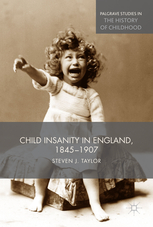

In the twenty-first century, the mental health of children is under constant scrutiny and is a topic that is regularly discussed by the print and broadcast media, drawing on reports from researchers, practitioners, policy-makers, service-providers, charities, and user-led organizations. Although achieving and maintaining mental well-being has been established as an important goal for individuals and society, the mental health of children is believed to be suffering from the damage inflicted by family problems, financial difficulties, exam pressures, cyber-bullying, and any number of old and newly emerging threats. Increasing numbers of children are thought to need help, but Children and Adolescent Mental Health Services (CAMHS) in the UK are currently operating under severe budgetary constraints and are reportedly not easy to access. There are also many disturbing examples of the most vulnerable child patients being cared for in unsuitable settings such as police cells, adult wards, and secure facilities many miles from home.
Mental health provision has long been recognised as a “Cinderella” service but it is now starting to be acknowledged that children and adolescents are a particularly disadvantaged group with many providers apparently reluctant to take responsibility for them or address their distinctive needs. However, these problems are not new and must be understood within the overall development of mental health services. Steven Taylor’s book is therefore a timely as well as thoughtful contribution to historical and historically-informed debates. It will certainly set the agenda for future work. Taylor successfully highlights and challenges the marginalization of children within the voluminous historiography exploring the nineteenth-century asylum in ways that other scholars will now have to address. He also persuasively argues that our understanding of Victorian and Edwardian childhood is impoverished without proper consideration of efforts to construct and manage the problem of the insane child.
This is important work, and a very ambitious project for an early-career scholar. There is much that is praiseworthy, including some really poignant case studies that are accompanied by an insightful and imaginative commentary. However, there are also some serious problems with the book and a robust review is encouraged by the unexpectedly critical approach Taylor takes when assessing the existing historiography. The introductory chapter very carefully sets out the parameters for the rest of the study but although Taylor makes a good case for adopting his preferred definitions of “pauper,” “lunatic,” and “child,” these still seem somewhat arbitrary given the contested nature of some of the concepts and their fluidity over time. He perhaps too readily assumes that pauperism implied destitution when many scholars have revealed the surprisingly diverse social and economic backgrounds of patients admitted to pauper lunatic asylums. This means that some of Taylor’s reasoning about why child patients were sent to different institutions strikes a discordant note although his idea of a network of institutions, and even a trade in child lunatics, will usefully inform future studies.
The terminology around lunacy is also deeply problematic, because as Taylor correctly points out the Lunacy Laws applied to individuals who we would now understand to have neurological conditions and/or learning disabilities as well as patients experiencing mental health crises more familiar to modern practitioners. Chapters 2-4 concentrate on what Taylor describes as the “narratives” of the 773 children admitted to his five study asylums. The majority of these cases were described in contemporary records as “idiots” and “imbeciles,” and Taylor understandably devotes whole sections of his book to exploring how ideas about childhood insanity were shaped by growing interest in what Mathew Thomson terms “the problem of mental deficiency.”[1] My personal work has concentrated on the implementation of the 1913 Mental Deficiency Act and I am somewhat surprised that this major piece of legislation was not taken as the end point of Taylor’s study. Instead Taylor opted to finish with the creation of the School Medical Service, an initiative that fits well with the educational themes he explores in chapter 5.
Care outside of the asylum was undeniably important, and I particularly liked the way Taylor identified a number of strategic sites where all children were subject to increasing surveillance by statutory and voluntary organizations. Some of these, especially the development of special schools, have been well-documented in other studies but Taylor usefully extends analysis to hospitals and a number of charities. The section on home care was unfortunately rather brief and potentially very interesting work on the census seems somewhat abbreviated.[2] Surprisingly, the book pays little attention to the operation of the civil or criminal courts, or indeed the wider criminal justice system, but Taylor develops an innovative and important analysis of different patterns of child emigration from regions of the UK.
It is clear that Taylor’s concerns are framed by his definition of the child, who for the purposes of his study is identified as a person under the age of fourteen. Taylor sets out his thinking on this point in some detail in the introduction and offers further explanation and clarification in later sections of the book. His reasoning is sound but the result is somewhat unfortunate as it is generally understood that adolescence rather than early childhood is the period when mental health issues really become apparent. There are many persuasive arguments in favor of extending the study to capture some, even all, of the adolescents who would now fall into the care of CAMHS. Taylor certainly acknowledges that the younger children in his study were more likely to be mentally disabled or suffer from epilepsy. Yet Taylor also appreciates that the construction of the “idiot” or “imbecile” child in the Victorian age, allowed for an extended period of childhood. The specialist idiot asylums certainly preferred to admit children aged seven to fourteen, but permitted their retention until the age of twenty-one.
This policy changed only slowly in the era of the Mental Deficiency Acts and I would argue that in the early twentieth century the age of sixteen was established as just one important demarcation between child and adult inmates at the Royal Western Counties Institution (RWCI) at Starcross in Devon. At this point, children admitted as education cases were not just formally reassessed and re-certificated as Mental Deficiency Act cases but they also generally stopped attending the institution’s school and entered both the adult wards and the adult work programmes. Yet this was not the whole story. Every certificate was then routinely re-issued every five years to allow for continuing detention but certain cases received special attention when they reached the age of twenty-one, the legal age of majority. Interwar and post-war court cases continued to draw a distinction between the treatment of patients who had and had not reached the age of twenty-one, and in a wide-ranging discussion about single mothers and the Mental Deficiency Acts Jane Robinson made the important point that the fate of the unmarried mother and her baby was entirely in the hands of the girl’s parents if she was under the age of twenty-one, even if she was financially independent and living away from home.[3]
Raising the age limit to consider patients under the age of sixteen, or even twenty-one, would, I think, have added to Taylor’s study without undermining any of his important conclusions. The question of age raises another potential problem. While an adult lunatic only ceased to be in that category if they recovered or died, the child lunatic may at some point have stopped being an insane child and started being treated as an adult lunatic. This is not an issue that seems to interest Taylor, and indeed many of the children in his study died at such a young age that there was no question of their re-categorization. However, a number of long-stay residents can be identified, especially in the rural asylums considered by Taylor, and while they were undoubtedly admitted as child lunatics they may have become something else over time. The gradual development of specialist facilities (wards, annexes, or whole institutions) at least implied that the child patient would at some point leave the children’s service and enter the adult asylum world.
These transitions between different services were, and indeed still are, deeply problematic but when considering decisions about the ongoing care needs of an adult, even middle-aged or elderly, patient it is not clear how much weight contemporary actors gave to their original status as a child lunatic. Yet my own work on the RWCI suggests that the original admission (including when and how it came about) was an important factor that helped explain patterns of discharges over many decades. The youngest, and usually most disabled, residents tended to die in the institution whereas more of the school-age entrants progressed towards discharge. In contrast older admissions (aged 16+) were often candidates for long-term detention because of a prior record of disturbed and/or criminal behaviour.
One of the major strengths of Taylor’s work is the comparative approach taken to the study of different institutions. While contrasting asylums serving urban areas with rural ones seemed perhaps too simplistic at first reading I found the analysis offered fascinating and think the book opens up many interesting avenues for future research. Taylor’s contribution benefits from being well-informed about all the five study institutions and the context they operated within, for example drawing attention to the unique provision offered by the Metropolitan Asylums Board when considering admissions to, and discharges, from Colney Hatch. Taylor’s discussion of the Prestwich Asylum then introduces some really interesting ideas about Poor Law policies and practices in the north-west of England that nicely dovetail with conclusions originally offered by Felix Driver.[4] Taylor also has interesting things to say about asylums serving rural areas and the potential for institutions, such as Berrywood in Northamptonshire, to make money by admitting out-of-county child lunatics into specialist wards and annexes.
It is perhaps strange, however, that none of the asylums Taylor selected for study enjoyed a reputation as a specialist centre for dealing with child patients. This seems to have been a deliberate policy,[5] and probably reflects difficulties accessing records, but again there is something rather arbitrary about the chosen case studies. The geographical, and chronological, coverage of the book could easily have been extended by drawing on the many existing studies that mention, however briefly, child lunatics. Taylor seems quite distrustful of the historiography, pointing out that it too often “overemphasises local quirks, overstates variations between institutions examined in different contexts, and simultaneously overlooks nuances in broader typological, regional and national trends.”[6] These are certainly concerns, but there are many excellent studies that can only enrich our collective understanding of childhood insanity.
In his history of the Norfolk Asylum, Steven Cherry makes many interesting points about why so few children were admitted to that institution in the nineteenth century and includes an unusual photograph of a neatly dressed girl inmate standing calmly alongside equally smart nurses.[7] Cherry goes on to explain efforts to get the twenty-two child patients resident in 1914 removed under the Mental Deficiency Acts, and then explores the twentieth-century co-development of the mental hospital and the Little Plumstead colony.[8] Returning to the nineteenth century, Anna Shepherd carefully considered the admittedly small numbers of child and adolescent patients treated at both the Brookwood Asylum and Holloway Sanatorium.[9] At Brookwood contemporary commentators had noted the undesirability of housing children with adult female lunatics and despite a stated preference for an entirely separate facility had dedicated small rooms for the exclusive use of male and female children. Shepherd notes that these rooms were described as “well off for toys.”[10] Other studies need to be trawled for similarly valuable insights into the care of mentally ill and mentally disabled children and it is rather disappointing that Taylor offers no comprehensive bibliography to complement the extensive references that appear at the end of each chapter.
While the social history of madness has understandably been pre-occupied with questions about class and gender,[11] it is now clear that age was also an important determinant of asylum careers. Taylor’s study makes a number of important contributions to broadening and deepening our understanding of the asylum world, especially in his discussions about the causes of insanity, the paths to and through different institutions, and the treatments offered to lunatic children. Taylor shows the value of properly connecting the asylum based studies with a much broader understanding of the history of childhood, but arguably attention also needs to be given to tracing the early twentieth-century rise of “child psychiatry” and its preoccupations with the nature versus nurture debate in different national contexts.[12] It is my hope and expectation that this important new work will stimulate further publications and also encourage scholars to revisit and re-examine existing literature exploring child insanity inside and outside of the asylum.
Reviewed by Pamela Dale, University of Exeter
Child Insanity in England, 1845-1907
by Steven J. Taylor
Publisher: Palgrave Macmillan
Hardcover / 188 pages / 2017
ISBN 9781137600264
References:
[1] Mathew Thomson, The Problem of Mental Deficiency: Eugenics, Democracy and Social Policy in Britain c.1870-1959 (Oxford: Clarendon Press, 1998).
[2] Steven Taylor, Child Insanity in England, 1845-1907 (London: Palgrave Macmillan, 2017), 156-157.
[3] Jane Robinson, In the Family Way: Illegitimacy between the Great War and the Swinging Sixties (London: Viking, 2015).
[4] Felix Driver, Power and Pauperism: The Workhouse System 1834-1884 (Cambridge: Cambridge University Press, 1993).
[5] Taylor, Child Insanity, 7.
[6] Taylor, Child Insanity, 174.
[7] Steven Cherry, Mental Health Care in Modern England: The Norfolk Lunatic Asylum/St Andrew’s Hospital c. 1810-1998 (Woodbridge: Boydell Press, 2003), 127.
[8] Cherry, Mental Health Care, 180-181.
[9] Anna Shepherd, Institutionalizing the Insane in Nineteenth-Century England (London: Pickering and Chatto, 2014), 84-88.
[10] Shepherd, Institutionalizing the Insane, 87.
[11] Jonathan Andrews and Anne Digby, ed., Sex and Seclusion, Class and Custody: Perspectives on Gender and Class in the History of British and Irish Psychatry (Amsterdam: Rodopi, 2004).
[12] Melvin Lewis, David Musto, Linda Mayes, and Kathleen Buhl, “Environmental Influences on Child Psychiatry,” in A Century of Psychiatry, ed. Hugh Freeman (London: Mosby, 1999), 81-86.
Published on July 3, 2017.




